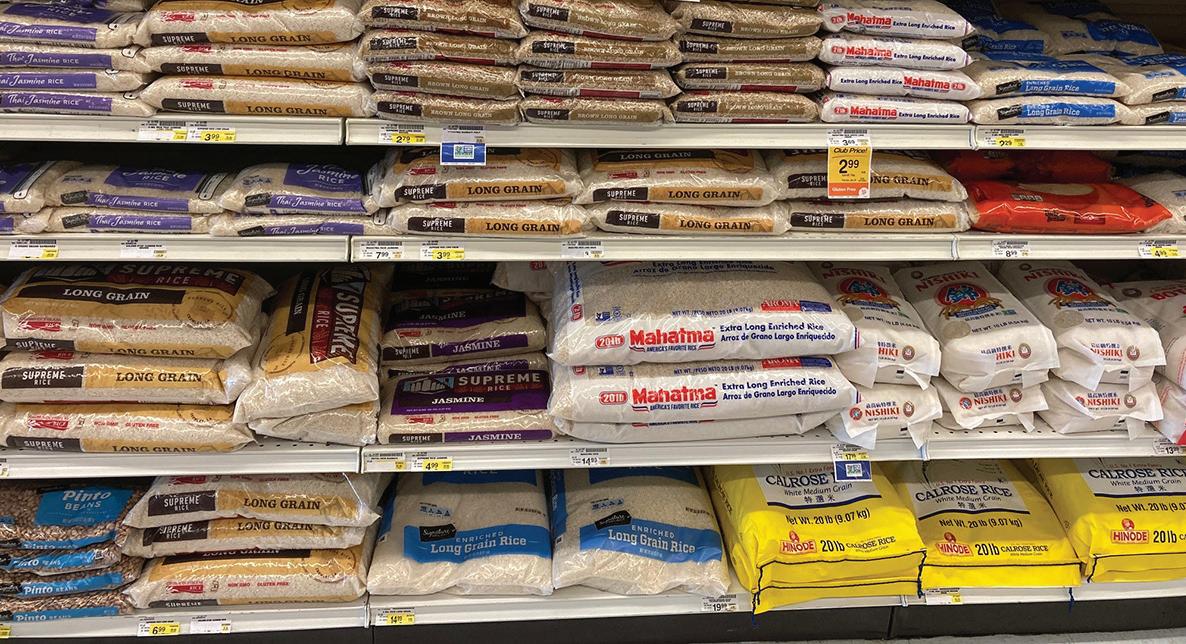
4 minute read
Several new crop-protection products
Domestic rice markets continue to shine as exports lag
By Kurt Guidry
As we head into planting season for the 2021 rice crop, the current cash rice market in Louisiana has remained supported in the $20 to $21 per-barrel range ($12.35 to $12.96 per hundredweight). A 500,000 acre increase in 2020 plantings resulted in a nearly 23% increase in total rice production. But tight stocks to start the marketing year, along with strong domestic demand, has firmed the market.
Domestic rice use has been the bright spot in 2020. Some of this better-than-expected domestic demand has been due to the COVID pandemic as consumers stockpiled staple food products and increased consumption of at-home meals. The U.S. Department of Agriculture’s initial estimate for total domestic rice use for the 2020-21 marketing year was 137.5 million cwt in May 2020.
By December 2020, the USDA had increased its projection to 145.5 million cwt and in its January 2021 report, increased it yet again to a record 160 million cwt.
Domestic use up, exports down
While domestic rice use steadily improved through 2020, the same cannot be said for rice exports, which ended 2019 and started 2020 with great promise. Stronger-than-normal sales during that period provided firm price support coming off a smaller 2019 crop.
As we moved deeper into the 2020 calendar year, exports faced increased competition and COVID-related restrictions as well as slowing short-term purchasing by customers. Export sales at the start of the 2020-21 marketing year lagged the previous year’s pace despite some larger purchases from nontraditional customers.
The level and pace of those purchases have not been consistent enough to override reduced sales to some of the historically large and traditional customers. Through the first week in February, total rice exports are down about 10% from the previous year. The slower pace over the last half of 2020 has caused the USDA to reduce its estimate for total rice exports for the 2020-21 marketing year from its initial projection of 100 million cwt to 93 million cwt.
Demand outlook remains positive
While still being behind last year’s pace, export sales have shown some signs of improvement over the past few weeks.
Along with expectations for reduced acreage and production in 2021, the short-term outlook for rice continues to look stable and helps build a solid foundation for the market heading into the 2021 crop year. On Feb. 19, the USDA released estimates for the supply and demand levels for the 2021-22 marketing year.
In those projections, the USDA pegged 2021 rice acres at 2.7 million acres, down roughly 300,000 acres from the previous year. Stronger prices for soybeans and corn are expected to produce acreage shifts in several rice-producing states.
News from Arkansas indicates acres in 2021 could be as much as 10% lower than 2020, which would account for about half of USDA’s reduction in total rice acres. Smaller shifts are also expected for other rice-producing states and could be larger if prices for competing crops continue to improve. While there is still some uncertainty where rice acres will end up in 2021, it seems probable that acres and production will be lower.
Short-term price support
Reduced acreage and production coupled with the current strong demand should continue to provide support for rice prices in the short term. The question becomes whether demand can continue this way over the next year. The USDA expects a slowdown of domestic use and has reduced overall expectations by 9 million cwt.
Even with this reduction, domestic use is still projected at historically high levels. For exports, the USDA projects a 2 million cwt reduction for the 2021-22 marketing year as uncertainty and competition in the world market continues. While demand is expected to be lower, those reductions are offset by lower supplies, leaving ending stocks mostly unchanged.
With stable ending stocks, it is logical to project prices to also remain fairly stable in the $20 to $21 per-barrel range ($12.35 to $12.96 cwt) for the 2021 crop year. New-crop futures prices are currently trading in that range at $12.80 per cwt, which helps to reinforce the projection for stable prices.
Given current market conditions and projections, it appears that downside risk for the market is limited with some upside potential on a market shock. While not as tight as this time last year, the relatively current positive stock situation should create some additional sensitivity in the market. This could provide some limited price movement on a positive shock to the market — such as lower-than-expected acres and production or higher-than-expected export demand.
Domestic rice use continued to exceed expectations as consumers stockpiled food during the COVID pandemic and ate more meals at home.
Dr. Kurt Guidry is Southwest Region director and Extension economist with the Louisiana State University AgCenter in Crowley. He may be reached at KMGuidry@agcenter.lsu.edu.








